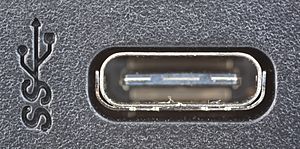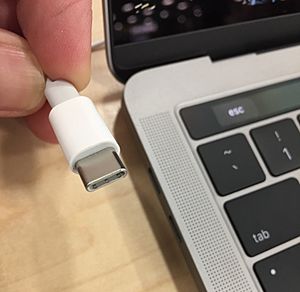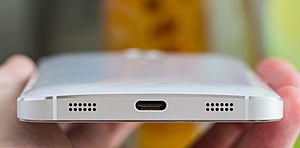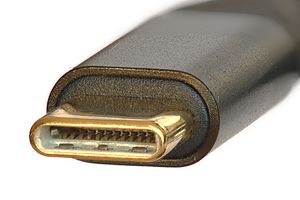USB-C facts for kids
Quick facts for kids USB-C |
||
|---|---|---|
| Pins of the USB-C connector | ||
| Type | Digital audio / video / data connector / power | |
| Production history | ||
| Designer | USB Implementers Forum | |
| Designed | 11 August 2014 (published) | |
| Superseded | Micro-USB (on Android devices) | |
| Specifications | ||
| Pins | 24 | |

USB-C, also known as USB Type-C, is a modern type of USB connector. It has 24 pins and a special design that lets you plug it in either way up. This means no more fumbling around trying to find the right side! The "C" in USB-C just describes its physical shape, not how fast it can transfer data. The speed depends on the USB version it uses, like USB 3.2 or USB4.
The first USB Type-C design was finished in August 2014 by the USB Implementers Forum (USB-IF). Later, it became an international standard. A device with a USB-C port might not use all the latest USB features. The USB-C connector is used for many different technologies.
USB 3.2, released in 2017, uses the USB-C connector to send data even faster. USB4, released in 2019, is the first USB standard that only works with USB-C.
Contents
What is USB-C?
USB-C cables connect computers and devices. They are designed to replace many older cables. This includes older USB types like USB-A and USB-B. They can also replace cables for video (like HDMI and DisplayPort) and audio (like 3.5 mm audio jacks).
The Name USB Type-C
USB Type-C and USB-C are official names. They are protected by the USB Implementers Forum.
USB-C Connectors


The USB-C connector has 24 pins and can be plugged in from either side. It's a bit bigger than the older micro-B connector. A USB-C port is about 8.4 millimeters wide and 2.6 millimeters high.
There are two main kinds of USB-C connectors:
- Plugs: These are found on cables and adapters.
- Receptacles: These are the ports found on devices like phones and laptops.
USB-C Cables
Modern USB-C cables are called "full-featured." They have a small chip inside. This chip tells devices what the cable can do. For example, it tells them about its speed and how much power it can carry.
- USB-C cables for fast data (Gen 1) should be 2 meters or less.
- Faster cables (Gen 2) should be 1 meter or less.
- Some USB-C cables only support older, slower USB 2.0 speeds. These can be longer, up to 4 meters.
All USB-C cables can carry at least 60 watts of power. Some special cables can carry up to 100 watts. These high-power cables must have an "e-marker" chip. This chip identifies the cable and its power abilities. Charging ports should also clearly show how much power they can provide.
Full-featured USB-C cables can transfer data very quickly. They can reach up to 10 gigabits per second. There are also slower USB-C cables that only support USB 2.0 speeds (up to 480 megabits per second). It's a good idea to use USB-IF certified cables.
USB-C Devices
Devices can be hosts (like a computer) or peripherals (like a phone or external hard drive). Some devices, like mobile phones, can act as either. This means they can change roles depending on what they are connected to. For example, your phone could be a host when connected to a USB drive. It could be a peripheral when connected to your computer.
USB-C devices can also provide or use different amounts of power. They can use 1.5 amps or 3.0 amps (at 5 volts). They can also use the full USB Power Delivery system. This allows for much higher power levels.
Connecting an older device to a USB-C port needs a special cable or adapter. This cable would have a USB-A or USB-B plug on one end and a USB-C plug on the other.
USB-C Modes
USB-C can do more than just send data and power. It has different "modes" for special uses.
Audio Adapter Accessory Mode
Some USB-C ports can work with analog headphones. You use an adapter with a 3.5 mm jack. This adapter provides the standard audio connections. It might also have a USB-C port to charge your device at the same time.
Alternate Mode
Alternate Mode lets USB-C cables send different types of data. This means the cable can carry video signals like DisplayPort or HDMI. It can also carry Thunderbolt data. These modes use some of the wires inside the USB-C cable for these special tasks.
USB-C Specifications
The USB Type-C specification defines how the cables and connectors work. It has been updated several times. The latest version, Rev 2.1, allows for much higher power delivery, up to 240 watts. This is called Extended Power Range (EPR).
Receptacles
The USB-C port on a device has 24 pins. These pins handle power, ground, and different types of data. There are pins for high-speed USB data and for even faster SuperSpeed data. There are also special pins for "Sideband Use" (SBU) and "Configuration Channel" (CC). The CC pins help the devices figure out how to connect.
Plugs
The USB-C plug on a cable also has 24 pins. It has one set of pins for USB 2.0 data. One of its CC pins is used to power special electronics inside the cable. The other CC pin handles the "Configuration Channel" signals. These signals help the cable and device know which way the cable is plugged in. They also help with USB Power Delivery.
Software Support
Many operating systems support USB-C. This includes:
- Android (from version 6.0 "Marshmallow")
- ChromeOS (from Chromebook Pixel 2015)
- iOS (from version 12.1 on newer iPads)
- Linux (from kernel version 2.6.31 for USB 3.0)
- OS X Yosemite (macOS version 10.10.2)
- Windows 8.1 and Windows 10
Hardware Support
More and more devices now have USB-C ports. This includes:
- Motherboards
- Laptops
- Tablet computers
- Smartphones
- Hard drives
- USB hubs
Video Output
Many devices use USB-C for video output. This is especially true for phones and laptops that don't have regular video ports. You can use a USB-C multiport adapter. This adapter converts the video signal to DisplayPort, HDMI, or VGA. This lets you connect your device to a TV or computer monitor.
USB-C is also used in docking stations. A single USB-C cable can connect your device to power, an external screen, and other USB devices. Some monitors even have these functions built-in.
Compatibility Issues
Sometimes, there can be problems with USB-C cables and devices.
Power Issues with Cables
Some USB-C cables are not made correctly. Using these bad cables can damage your devices. For example, some cables might incorrectly tell a device how much power it can draw. This can lead to too much power going to the device. This has caused damage to laptops and chargers.
To avoid problems, always use certified USB-C cables.
Audio Adapter Compatibility
Many newer phones don't have a traditional 3.5 mm headphone jack. Instead, they use the USB-C port for headphones.
There are two main types of USB-C audio adapters:
- Active adapters: These have a built-in digital-to-analog converter (DAC). They take digital audio from your device and turn it into analog sound for your headphones. These work with most devices.
- Passive adapters: These do not have a DAC. They rely on your phone to send out analog audio directly through the USB-C port. These only work with devices that support analog audio output via USB-C.
Fast Charging Compatibility
Some older fast-charging technologies, like Quick Charge 2.0 and 3.0, were not fully compatible with the USB-C standard. However, newer versions like Quick Charge 4 are designed to work with USB-C and its power delivery features.
Regulations for Compatibility
The European Union has made a new law. By the end of 2024, all mobile phones, tablets, and cameras sold in the EU must have a USB-C port. This rule will also apply to laptops by spring 2026. The goal is to have a single, universal charger for many devices.
Images for kids
See also
 In Spanish: USB-C para niños
In Spanish: USB-C para niños
- USB hardware § Host and device interface receptacles
- Thunderbolt (interface)
- HDMI Version 2.1



